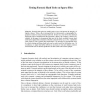Free Online Productivity Tools
i2Speak
i2Symbol
i2OCR
iTex2Img
iWeb2Print
iWeb2Shot
i2Type
iPdf2Split
iPdf2Merge
i2Bopomofo
i2Arabic
i2Style
i2Image
i2PDF
iLatex2Rtf
Sci2ools
IMF
2007
2007
Testing Forensic Hash Tools on Sparse Files
: Forensic hash tools are usually used to prove and protect the integrity of digital evidence: When a file is intercepted by law enforcement, a cryprographic fingerprint is taken by using a forensic hash tool. If later in a court of law the identical fingerprint can be computed from the presented evidence, the evidence is taken to be original. In this paper we demonstrate that most of the freely available forensic hash tools fail to support this conclusion at the file system level for sparse files, a particular class of files in Unix systems that contain holes. We describe an experimental setup by which existing and future hash tools can be easily tested for this border case. In conclusion, we argue that further efforts are necessary to test and validate common forensic hash tools so that the significance of their results can be better judged.
Available Forensic Hash | Forensic Engineering | Forensic Hash Tools | Future Hash Tools | IMF 2007 |
| Added | 29 Oct 2010 |
| Updated | 29 Oct 2010 |
| Type | Conference |
| Year | 2007 |
| Where | IMF |
| Authors | Harish Daiya, Maximillian Dornseif, Felix C. Freiling |
Comments (0)

